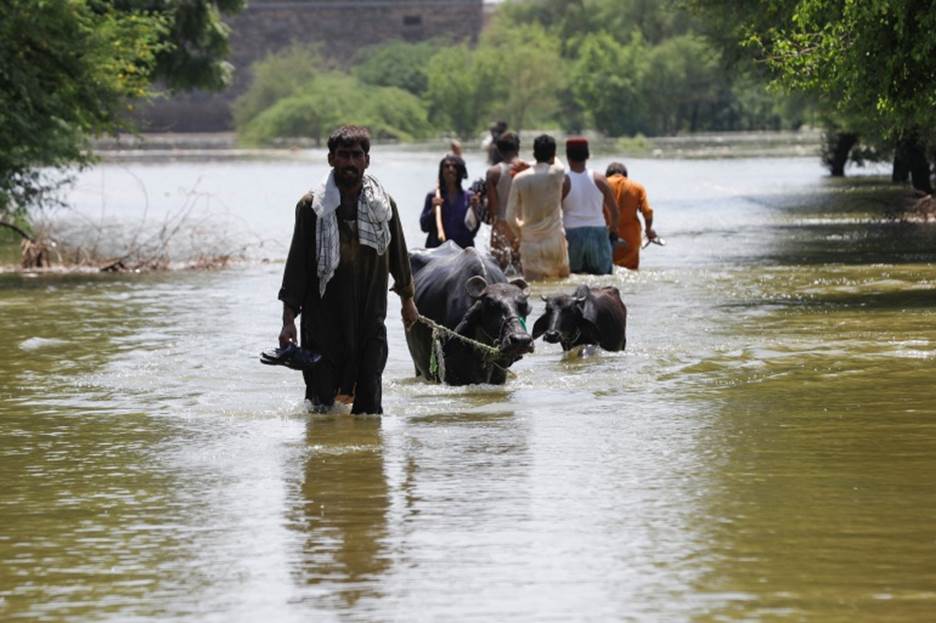

A man pulls his animals while others go to salvage their belongings amid rising flood water on the outskirts of Bhan Syedabad, Pakistan on September 8, 2022 [File: Reuters/Akhtar Soomro]
How Pakistan Can Prevent another Flood Disaster
By Mohsin Hafeez
As the flood waters receded across huge swathes of Pakistan in September, they revealed devastating losses. More than 1,500 people died, while 33 million suffered the loss of livestock, crops, homes and livelihoods. This tragedy has highlighted the desperate urgency of reinforcing climate defenses, in Pakistan and elsewhere.
Though the effect of this year’s deluge has been unprecedented, the number of major floods has already doubled over the last two decades and eight of the 10 countries most affected by climate disasters are in Asia.
Without greater long-term investment from the international community into science-based solutions, risk-proof infrastructure and national capacity, these kinds of climate extremes will continue to leave a trail of destruction in the countries that can least afford them.
The latest climate science makes clear that the only way to reduce the likelihood of similar events in the future is to bring down global emissions, predominantly in high-income countries.
But proven strategies also exist for buffering Pakistan and similarly vulnerable nations against the effect of floods, drought and heatwaves, which strike at the very heart of a country’s development by jeopardizing food systems, rural livelihoods and ecosystem health.
To take one example, early warning systems that make use of weather data and modelling can alert authorities to an expected flood and give them time to start evacuations and put in place contingencies for critical sectors, such as agriculture.
Flood inundation models , developed by the International Water Management Institute (IWMI) and partners, have helped to anticipate the depth and extent of flooding in Sri Lanka, allowing governments and communities to take preemptive measures that reduce the negative effects.
Insurance schemes supported by the government can also help small-scale farmers, businesses and households recover after a climate event. IWMI and its partners have piloted index-based flood insurance in India and Bangladesh, offering protection for agricultural livelihoods during floods, limiting the long-term effect on food systems and food security. Compensation for flood damage to crops totaled $150,000 between 2017 and 2020, allowing 7,000 families to repair their homes and farms, and recover from the losses.
Another example is the use of nature-based solutions, or green infrastructure, to harness the ability of ecosystems like wetlands to regulate water flow and absorb flood water.
Pakistan’s Water Apportionment Accord of 1991 allocated percentage rights to provincial governments to the Indus River, including the use of excessive flood water supplies to keep small storages for the provinces. However, water storage using nature-based solutions has not been practiced to date by any provincial government.
That should change. A 2018 study on flooding in Sri Lanka showed that wetlands could absorb 39 percent of the water during storms. In the 1970s, when the importance of these areas came to the fore, they accounted for some 7,800 square kilometers (3,010sq miles) of Pakistan’s territory. In recent years, many wetlands have been degraded due to human activity and climate change; restoring them could help manage future floods.
Similarly, restoring forests, or reforestation, can increase the resilience of ecosystems, prevent soil erosion, and reduce the risk of flash floods. The Pakistan government has already launched the Ten Billion Tree Tsunami project , a tree-planting initiative to revive forests and wildlife resources in the country. Planting and cultivating mangrove forests, for example, has also been found to help prevent coastal erosion.
Evidence-based frameworks for strengthening and managing the design and implementation of water infrastructure projects can also help climate-proof key services and sectors. The management of dams is one area where science can help make a difference.
In the case of the Gomal Zam Dam, on the border between Afghanistan and Pakistan, the problems with water governance could prevent the project from reaching its full potential. IWMI has been working with the Pakistani authorities to improve best practices in water management and incorporate scientific data to help minimize the negative effects of floods. Improving the management of other water infrastructure projects in Pakistan can help build more climate resilience on the local level.
Meanwhile, the agricultural sector also needs greater investment to develop and implement climate-resilient tools and technologies that better cope with the effect of flooding and droughts. For example, new varieties of crops and livestock bred to be more tolerant of climate extremes can help safeguard agricultural production and livelihoods, along with more diverse forms of water management for farming, including rainwater harvesting and managed aquifer recharge.
The flood may finally be over in Pakistan but it will not be the last. That is why it is crucial to embrace preventive science-based solutions and make sure that the effect of the next disaster does not reach the same scale. This will be the message of this year’s Pakistan Water Week to be held from October 24 to 28.
The good news is that the government of Pakistan has already started updating the national flood protection plan and adopting global best practices for updating the flood risk framework. Other governments should follow suit.
(Mohsin Hafeez is Pakistan Country Representative for the International Water Management Institute. – Al Jazeera)

